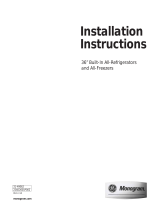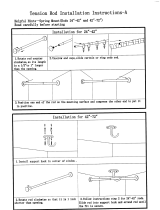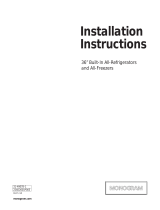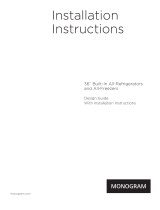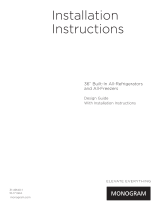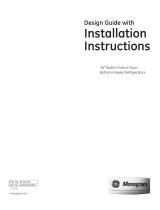
Design Guide with
Installation
Instructions
monogram.com
31-49074
224D3560P002
12-14 GE
36” Built-In French Door,
Bottom-Freezer Refrigerators

Safety Information
2
BEFORE YOU BEGIN
Read these instructions completely and carefully.
• IMPORTANT – Save these instructions for
local inspector’s use. Observe all governing codes
and ordinances.
• Note to Installer – Be sure to leave these
instructions with the Consumer.
• Note to Consumer – Keep these instructions with
your Owner’s Manual for future reference.
If you received a damaged refrigerator, you should
immediately contact your dealer or builder.
Skill Level – Installation of this refrigerator requires
basic mechanical, carpentry and plumbing skills.
Proper installation is the responsibility of the installer.
Product failure due to improper installation is not
covered under the GE Appliance Warranty.
See the Owner’s Manual for warranty information.
WARNING
Electrical Shock Hazard.
Plug into a grounded 3-prong outlet.
Do not remove the ground prong.
Do not use an adapter.
Immediately replace electric cords that become frayed
or damaged.
Do not use an extension cord with this appliance.
Failure to follow these instructions can result in death,
fire, or electrical shock.
Follow the instructions in the section Grounding the
Refrigerator.
This is the safety alert symbol. This symbol alerts you to potential hazards that can kill or hurt you and others.
All safety messages will follow the safety alert symbol and the word “DANGER”, “WARNING”, or “CAUTION”. These
words are defined as:
DANGER
Indicates a hazardous situation which, if not avoided, will result in death or serious injury.
WARNING
Indicates a hazardous situation which, if not avoided, could result in death or serious injury.
CAUTION
Indicates a hazardous situation which, if not avoided, could result in minor or moderate injury.
For Monogram local service in your area, call 1.800.444.1845.
For Monogram service in Canada, call 1.800.561.3344
For Monogram Parts and Accessories, call 1.800.626.2002.
www.monogram.com
WARNING
Tip Over Hazard.
These refrigerators are top heavy, especially with any doors open, and must be secured to prevent tipping
forward which could result in death or serious injury. Read and follow the entire installation instructions for
securing the refrigerator with the anti-tip system.
WARNING
Explosion Hazard.
Keep flammable materials and vapors, such as gasoline, away from refrigerator. Failure to do so can result in
fire, explosion, or death.
WARNING
To reduce the risk associated with choking, do not allow children under 3 years of age to have
access to small parts during the installation of this product.
CAUTION
Lifting Hazard
This refrigerator is very heavy. To reduce the risk of person injury during maneuvering and installing this
refrigerator, 3 people are required for proper installation.
Page is loading ...

Contents
4
Safety 2-3
Planning Guide
The Installation Space 5
Dimensions and Clearances 5
130° Door Swing 6
90° Door Swing 7
Side Panels 8
Installation Instructions
Tools, Hardware, Materials 9
Grounding the Refrigerator 9
Step 1. Remove Packaging 10
Step 2. Install Water Line 10
Step 2A. Water Line with Reverse Osmosis System 11
Step 3. Install Side Panels 11
Step 4. Anti-Tip Procedures 11-12
Step 5. Level Refrigerator 13
Step 6. Secure Unit to Wall 13
Step 7. Alternate Anti-Tip Procedure 14
Step 8. Secure Refrigerator to Cabinetry 14
Step 9. Connect Water Supply 15
Step 10. Connect Power 15
Step 11. Start Icemaker 15
Step 12. Install Toekick 16

5
Design Guide
36" Frame to
Frame Width
*84" From
Floor to
Top Frame
35"
Case Width
*83 1/2"
at
Rear
25-3/4" Stainless Steel Models
Case Depth
Depth Including Handles:
27-13/16" Stainless Steel Models
28-5/8" Professional Style Models
THE INSTALLATION SPACE
Water And Electrical Locations
Electrical and water supply must be located as shown.
The cutout depth must be 24
”
The refrigerator will project forward, slightly beyond
adjacent cabinetry, depending on your installation.
Allow minimum 1/8” air gap between case back & wall.
Cutout depth beneath a soffit:
When installed beneath a soffit, the soffit cannot exceed
the 24” installation depth shown. The top case trim
overlaps the bottom of the soffit.
Additional Specifications
• A 115 volt 60Hz., 15 or 20 amp power supply is required.
An individual properly grounded branch circuit or circuit
breaker is recommended. Install
a properly grounded 3-prong electrical receptacle
recessed into the back wall. Electrical must be located
on rear wall as shown.
Note: GFI (ground fault interrupter) is not recommended.
• Water line can enter the opening through the floor
or back wall. Route GE SmartConnect
™
kit or 1/4” O.D.
copper tubing between the cold water line and the
water connection location. The tubing should be
long enough to extend to the front of the refrigerator.
Installation of an easily accessible shut-off valve in the
water line is required.
DIMENSIONS AND CLEARANCES
* Shipping height. The
refrigerator can be
adjusted to fit into a
cutout that is 83-1/2
”
min. to 84-1/2
” max.
height. Note that the top
case trim at the front is
1/2
” higher and will
overlap upper cabinetry
or soffit. Use leveling
legs and wheels for a
maximum 1
” height
adjustment.
Product Clearances
These refrigerators are equipped with a 2-position door
stop. The factory set 130° door swing can be adjusted to
90° if clearance to adjacent cabinets or walls is restricted.
23-7/8"
Behind
Frame
90°90°
18-1/8"
18-3/16”
*4” Stainless and
Framed Models.
5” Pro Series
*Min. Distance
to Wall
(Stainless &
Pro Models)
(Framed
Models)
6"
Wall View
Electrical
Area
84-1/2" Max.
Finished
Opening
75" From
Floor to
Bottom
of Electrical Area
10"
24" Cutout Depth
35-1/2"
Finished Width
2-5/16"
5"
10"
10"
5"
3-1/2"
Water Supply
12-1/8"
Min. to
Wall
12-1/8"
Min. to
Wall
130°
130°
The finished
cutout width
must be
35-1/2”.
Allow 12-1/8” minimum clearance for a full 130° door
swing.
For a 90° door swing, allow 4” min. clearance to a wall,
for framed and stainless steel models. Allow 5” min.
clearance for professional style models. If the 90° door
stop position is used, pan access is maintained, but pan
removal is restricted.
See illustrations pages 6 and 7 to determine door swing
interaction with adjacent cabinets or countertops.

1/4"
1/2"
3/4"
1"
1-1/4"
1"
3/4" Overlay
Panel
(Nominal Size)
Stainless Steel
1/4"
1/2"
3/4"
2"
1-1/4"
1-1/2"
1-3/4"
3"
2-1/4"
2-1/2"
2-3/4"
1/4"
1/2"
3/4"
Door
23-7/8" From
Rear of
Refrigerator
1"
Refrigerator
Case
Trim
Top View
130° DOOR SWING
Scale 1:1
6
Frameless Cabinets: The case trim
overlaps cabinets at the top and sides.
Therefore, frameless cabinets
may require filler strips to prevent
interference with cabinet door swing.
The opening must allow for filler strips.
Design Guide

1/4"
1/2"
3/4"
1"
1-1/4"
1/4"
1/2"
3/4"
1"
1-1/4"
1-1/2"
23-7/8"
From Rear of
Refrigerator
3/4" Overlay
Panel
(Nominal Size)
Case Trim
Refrigerator
Door
Stainless Steel
7
Top View
90° DOOR SWING
Scale 1:1
Frameless Cabinets:
The case trim overlaps
cabinets at the top and
sides. Therefore, frameless
cabinets may require
filler strips to prevent
interference with cabinet
door swing. The opening
must allow for filler strips.
Design Guide

*84"
2-9/16"
24"
*3" to 4"
3/16"
1-7/8"
Design Guide
8
SIDE PANELS
Side panels must be used whenever the sides of the
refrigerator will be exposed. The 1/4” side panels will
slip into the side case trim. Secure the panels to the
refrigerator with stick-on hook and loop fastener strips.
Order the side panels from the cabinet manufacturer.
• Cut a notch in the top front corner as shown to allow
clearance for corner keys in the front side trim.
* Depending on
installation height.

9
TOOLS REQUIRED
• Tinsnips to cut banding
• Stepladder
• Bucket
• Level
• Appliance Hand Truck
• Tubing cutter
• 7/16” open-end wrench
• #2 Phillips screwdriver
• Drill and appropriate bits
• 5/16”, 7/16” socket
• Safety glasses
• 1-1/4” open end wrench
• Pliers
• 1/4” ratchet
MATERIALS REQUIRED
• 35” long 2x4 for Anti-Tip support
• 1/4” copper water line tubing or GE SmartConnect
™
Refrigerator Tubing kits
• Water shut-off valve
• Custom panels for fresh food door, freezer drawer and
grille panel
• Screws to secure refrigerator to cabinetry.
• Stick-on hook and loop fastener strips for
1/4” side panels
HARDWARE SUPPLIED
• Water filter bypass plug
• Anti-Tip brackets
• 1/4” nut and ferrule
• Flush inset bracket pack
• Case trim(s)
FLOORING
For proper installation, this refrigerator must be placed
on a level surface of hard material that is at the same
height as the rest of the flooring. This surface should be
strong enough to support a fully loaded refrigerator, or
approximately 1,200 lbs.
NOTE: Protect the finish of the flooring. Cut a large section
of the cardboard carton and place under the refrigerator
where you are working.
REFRIGERATOR LOCATION
• Do not install the refrigerator where the temperature
will go below 60°F (16°C). It will not run often enough to
maintain proper temperatures.
• Do not install the refrigerator where temperatures will go
above 100°F (37°C). It will not perform properly.
• Do not install the refrigerator in a location exposed to
water (rain, etc.) or direct sunlight.
• Install it on a floor strong enough to support it fully
loaded.
Installation Instructions
GROUNDING THE REFRIGERATOR
WARNING
Electrical Shock Hazard.
Failure to follow these instructions can result in death,
fire, or electrical shock.
The power cord of this appliance is equipped with a
3-prong (grounding) plug which mates with a standard
3-prong (grounding) wall receptacle to minimize the
possibility of electric shock hazard from this appliance.
Have the wall outlet and circuit checked by a qualified
electrician to make sure the outlet is properly
grounded.
Where a standard 2-prong wall outlet is encountered, it
is your personal responsibility and obligation to have it
replaced with a properly grounded 3-prong wall outlet.
DO NOT, UNDER ANY CIRCUMSTANCES, CUT OR
REMOVE THE THIRD (GROUND)
PRONG FROM THE POWER CORD.
DO NOT USE AN ADAPTER PLUG
TO CONNECT THE REFRIGERATOR
TO A 2-PRONG OUTLET.
DO NOT USE AN EXTENSION
CORD WITH THIS APPLIANCE.
MISE À LA TERRE DU RÉFRIGÉRATEUR
AVERTISSEMENT
Risque de choc électrique.
Le non-respect de ces instructions peut entraîner des
risques d’incendies, des chocs électriques ou la mort.
Le cordon d’alimentation de cet appareil est équipé
d’une fiche à trois broches (pour une mise à la terre)
qui s’adapte à la prise de courant standard à 3
broches (pour une mise à la terre) pour minimiser les
risques de chocs électriques par cet appareil.
Faites vérifier la prise murale et le circuit électrique par
un électricien qualifié pour s’assurer que le système est
correctement mis à la terre.
Dans le cas d’une prise biphasée, l’installateur a la
responsabilité et l’obligation de la remplacer par une
prise triphasée correctement mise à la terre.
NE COUPEZ PAS OU N’ENLEVEZ PAS, SOUS AUCUN
PRÉTEXTE, LA TROISIÈME BROCHE DE MISE À LA TERRE
DU CORDON D’ALIMENTATION.
N’UTILISEZ PAS D’ADAPTATEUR
POUR BRANCHER LE
RÉFRIGÉRATEUR À UNE PRISE
BIPHASÉE.
N’UTILISEZ PAS DE RALLONGE
AVEC CET APPAREIL.

STEP 2 INSTALL WATER LINE
• A cold water supply is required for automatic
icemaker operation. The water pressure must be
between 40 and 120 p.s.i.
• Route 1/4” OD copper or GE SmartConnect
™
plastic
tubing between house cold water line and the water
connection location.
• Tubing should be long enough to extend to the front of
the refrigerator. Allow enough tubing to accommodate
bend leading into the water line connection.
NOTE: The only GE-approved plastic tubing is supplied
in the GE SmartConnect
™
Refrigerator Tubing kits. Do not
use any other plastic water supply line because the line
is under pressure at all times. Other types of plastic may
crack or rupture with age and cause water damage to
your home.
GE SmartConnect
™
Refrigerator Tubing Kits are available
in the following lengths:
2‘ (.6 m) WX08X10002
8’ (2.4 m) WX08X10006
15’ (4.6 m) WX08X1 0015
25’ (7.6 m) WX08X10025
Shut off the main water supply.
Turn on the nearest faucet long enough to clear the line of
water.
• Install a shut-off valve between the icemaker water
valve and cold water pipe in a basement or cabinet. The
shut-off valve should be located where it will be easily
accessible.
• Turn on the main water supply and flush debris. Run about
a quart of water through the tubing into a bucket. Shut off
water supply at the shut-off valve.
NOTE: Saddle type shut-off valves are included in many water
supply kits, but are not recommended for this application.
10
Installation Instructions
NOTE: Commonwealth of Massachusetts Plumbing Codes
248CMR shall be adhered to. Saddle valves are illegal and
use is not permitted in Massachusetts. Consult with your
licensed plumber.
STEP 1 REMOVE PACKAGING
WARNING
Tip Over Hazard.
Refrigerator is much heavier at the top than at the
bottom. To avoid a risk of death or serious injury, be
careful when moving, and when using a hand truck,
handle only from side.
DO NOT ATTEMPT TO ROLL UNIT OFF SKID.
AVERTISSEMENT
Risque de basculement
Parce que le haut du réfrigérateur est plus lourd que sa base,
la prudence est de mise lors son déplacement, de l’utilisation
d’un diable-brouette, de sa manipulation faite seulement sur
son côté afin d’éviter les blessures graves ou mortelles.
IL NE FAUT PAS ESSAYER DE FAIRE ROULER L’APPAREIL
MÉNAGER POUR L’ENLEVER DE LAY PALETTE..
• Carefully cut banding at the top and bottom, remove the
outer carton.
• Slide out the back corner posts (2).
• Slide the carton off the top of the cabinet.
NOTE: IT IS NOT NECESSARY TO LAY THE CABINET DOWN
IN ORDER TO REMOVE THE SKID!
• The unit is secured to the
skid with 2 full-length
tie-down straps. Remove
the ten 5/16” bolts from the
base channels in the tie-
downs.
• Remove the four 7/16”
bolts securing the straps to
the skid.
NOTE: DO NOT ATTEMPT TO
ROLL UNIT OFF SKID.
• The support blocks on the
bottom of the refrigeration
case must be removed
before the refrigerator is taken off the skid or damage
will occur. Carefully tilt the refrigerator and slide the
blocks out from beneath.
• Remove the toekick and set aside for final installation.
• Lift the refrigerator off the skid with an appliance dolly.
Handle from the sides.
Remove 2 strap
bolts on each side
Remove 5
base channel
bolts on each
side
Floor
Waterline Tubing

11
STEP 2A
WATER LINE INSTALLATION WITH
A REVERSE OSMOSIS SYSTEM
Skip this step when not using an RO System
If the water supply to the refrigerator is from a Reverse
Osmosis Water System, use the refrigerator’s filter bypass
plug. Using the refrigerator’s water filtration cartridge with
the RO filter can result in hollow ice cubes.
STEP 3
INSTALL SIDE PANELS
Skip this step when not using side panels
If you are using 1/4
”
side panels, they should be inserted
into the case trim. Fasten the panels to the refrigerator
with stick-on hook and loop fastener strips before setting
refrigerator in place.
Filter Bypass Plug
Installation Instructions
STEP 4
ANIT-TIP PROCEDURE
WARNING
Tip Over Hazard.
These refrigerators are top heavy, especially
with any doors open, and must be secured to
prevent tipping forward which could result in
death or serious injury. Read and follow the
entire installation instructions for securing the
refrigerator with the anti-tip system.
AVERTISSEMENT
Risque de
basculement
Ces réfrigérateurs présentent une partie
supérieure lourde, en particulier avec une porte
ouverte; ils doivent donc être fixés pour prévenir le
basculement vers l’avant et le risque concomitant
de blessure grave ou fatale. Lisez et suivez
les instructions d’installation complètes pour
l’installation du système anti-basculement.
STEP 4
ANIT-TIP PROCEDURE
(CONT)
• The kit supplied with the unit contains 2 lag bolts and 4
toggles with bolts. The wall bracket will be attached to
the wall in 4 places.
• Measure the opening where the unit is to be installed.
Mark the center with a vertical line.
• Measure up 81 1/2” from the floor. Mark this point on
the wall.
• Using a level, draw a horizontal line on the wall at this
height.
• Locate at least 2 studs on the back wall. Mark these
points on the horizontal line.
• Place the bottom of the wall bracket with tabs on the
horizontal line. Align the center notch on the bracket
with the center line on the wall.
Line on Wall
Center

12
Installation Instructions
STEP 4
ANIT-TIP PROCEDURE
(CONT)
• The anti-tip wall bracket has a series of holes. Select 2
holes that match with the located studs. Make sure the
holes selected are on the center of the studs. Mark the
wall at these points.
• Mark an additional hole at each end of the bracket. If one
of the studs is closer to the end of the bracket, mark an
additional hole towards the center of the bracket.
• Drill 1/2” holes into the wall board at the locations marked
for the toggles to be mounted (not the stud markings).
• Drill 3/16” holes into wooden studs where marked. If steel
stud construction, drill 1/2” holes into the studs where
marked. You will use 2 toggles with the metal studs.
Install Wall Toggles:
The wall toggles and bolts can be ordered as Service Kit
#WR49X10193. Wall toggles are installed in the drywall
and metal studs for stability. Install the wall toggles as
follows:
• Drill 1/2” holes at the wall markings made in the holes
at the ends of the wall bracket.
• Hold the metal channel flat against the plastic straps
and slide the channel through the hole.
• Gently pull back at the ends of the plastic straps to
make the channel rest flush behind the wall.
• Hold the ends of the straps in one hand and slide the
plastic cap along the straps until the flange of the cap
is flush with the wall.
Two Additional
Hole Locations at
Ends of Brackets
Center
Wall Bracket
Line On Wall
Wall Studs
Plastic Straps
Metal Channel
Cap
STEP 4
ANIT-TIP PROCEDURE
(CONT)
• Place your thumb between the plastic straps and bend
up and down to snap the straps off at the wall.
Install Screws and Bolts:
• Have someone hold the wall bracket centered in place
with each of the holes aligned with the correct opening
in the bracket and level with the horizontal line.
• Insert the lag screws through the bracket and into the
stud. Tighten with a wrench.
• Insert the bolts into the toggle by hand until snug.
Tighten with a wrench.
CONNECT POWER CORD:
• Before pushing the refrigerator into the opening, plug
the power cord into the receptacle. Open the grille
panel and reach into the opening at the back to grasp
the power cord. Pull the power cord into the opening
as you push the refrigerator back.
• Gently push refrigerator into the opening with hands
against front corners.
Wood Stud
Lag Screw
Anti-Tip Wall Bracket
Anti-Tip Wall Bracket
Bolt
Wall Toggle
Drywall or
Steel Stud

13
STEP 5 LEVEL REFRIGERATOR
All models have 4-point leveling. The front is supported
by leveling legs, the rear is supported by adjustable
wheels. Both are accessible from the front of the
refrigerator.
• To level the back of the refrigerator, turn the 7/16” hex
nut located above the front wheels. Turn clockwise to
raise or counterclockwise to lower the refrigerator.
• For front leveling, use a 1-1/4” open-end wrench.
• Adjust height of refrigerator to match installation
cutout opening 83-1/2 to 84-1/2”. The refrigerator
should be level and plumb with cabinetry.
ATTENTION
Les roues de nivellement arrière et les pattes de
nivellement avant permettent un réglage maximal
de 25 mm (1 po). Si l’ouverture pour le réfrigérateur
a une hauteur supérieure à 2,15 m (84-1/2 po),
l’installateur doit élever le réfrigérateur sur une feuille
de contre-plaqué ou des glissières. Il est également
possible d’ajouter des baguettes de finition des
placards sur le haut de l’ouverture afin de la réduire.
Lever le réfrigérateur de plus de 25 mm (1 po)
endommage les pattes de nivellement avant
et les roues de nivellement arrière.
CAUTION
The rear leveling wheels and front leveling legs are
limited to a maximum height adjustment of 1”. If the
installation requires more than 84-1/2” height, the
installer should elevate the refrigerator on a sheet
of plywood or runners. Cabinetry trim could also be
added across the top of the opening to shorten the
opening. If you attempt to raise the refrigerator more
than 1”, you will damage the front leveling legs and the
rear leveling wheels.
Installation Instructions
STEP 6 SECURE UNIT TO WALL
• The “L” rod can be found in the upper left corner of
the unit in the access compartment. Look through the
access compartment to make sure the rod lines up
with the anti-tip bracket.
• There are 2 washers and a hair pin cotter with the rod.
Remove the washers and hair pin cotter from the end
of the rod.
• Rotate and move the
“L” rod into the slot in
the anti-tip bracket tab.
Once it is in the slot,
rotate the “L” rod so the
hook portion is pointing
down. The holes at the
front end of the rod
should be in a vertical
position.
• Pull out on the end of
the rod to make sure it is secure in the bracket.
• Locate the hole on the rod that is closest to the unit. A
hair pin cotter will be put through this hole to secure
the rod. If this hole appears to be too far away for a
snug fit against the unit, add the washers one at a time
until the pin will fit tightly into the hole.
• Align the straight section of the pin with the hole from
the underside of the rod. Push the pin up until it snaps
into position. Pliers may be used. NOTE: The hair pin
cotter must be vertical when this step is completed to
ensure the “L” rod is engaged in the bracket.
• Check the rod for tightness by pulling forward. If the
rod moves, remove the hair pin cotter and place
another washer on the rod. Reinsert the pin.

14
Installation Instructions
STEP 8 SECURE REFRIGERATOR
TO CABINETRY
Whenever possible, perform this step in addition to the
Anti-Tip Procedures for anti-tip security. The refrigerator
must be secured to prevent tipping.
• Raise the grille panel to access case trim.
• Drill hole in trim and drive screw through the trim into
adjacent cabinet.
• Follow the same procedure on the opposite side.
Drive screws through case trim
and into adjacent cabinets.
STEP 7 ADJUST DOOR SWING
NOTE: This refrigerator has a 2-position door stop.
When space does not allow the door to swing open
fully to 130°, you may change the door swing to a 90°
opening. Skip this step if door opening is satisfactory
for your installation situation.
• Lift the grille panel to access the wire cover trim.
• Remove screws on both sides of the wire cover trim
and rotate off.
• Use pliers to unscrew door stop and reinstall into the
90° position.
• Reinstall the wire cover trim.
Remove
Wire Cover
Trim Screws

15
Installation Instructions
STEP 9 CONNECT WATER SUPPLY
• Locate and bring tubing to the front of the cabinet.
• Turn the water on to flush debris from line. Run about
a quart of water through tubing into a bucket, then
shut off water.
Copper Tubing:
• Slip a 1/4” nut and ferrule (provided) over both ends
of the copper tubing. Insert tube into the union fitting
on the unit and tighten nut to union.
• Turn on the water to check for leaks.
GE SmartConnect
™
Tubing:
• Insert the molded end of the tubing into the
refrigerator connection. Tighten the compression nut
until it is just hand tight.
• Tighten one additional turn with a wrench.
Overtightening can cause leaks!
• Turn on the water to check for leaks.
Note: Make sure excess tubing length does not
interfere with drawer closing or toekick installation.
STEP 10 CONNECT POWER
• Check to be sure the power cord is plugged into the
receptacle.
• Check to make sure power to refrigerator is on by
opening refrigerator door to see if interior lights are
on.
• The temperature controls are preset at 37°F
for the fresh food section and 0°F for the freezer.
• Allow 24 hours to stabilize before making
adjustments.
STEP 11 START ICEMAKER
• Flip the switch to I (ON). The icemaker will begin
operation automatically.
• Be sure nothing interferes with the sweep of
the feeler arm.
• Discard the first full bucket of ice cubes.
• To turn the icemaker off, set the switch to O (OFF).
ON
OFF
Refrigerator
Water Supply
House
Water Supply
Electrical
Outlet
Raise
Grille
Panel

16
Installation Instructions
STEP 12 INSTALL TOEKICK
• Locate the 2 supplied toekicks (shipped taped to
the side of the refrigerator). Install the toekick
assembly with the 2 screws provided, adjust to the
desired height and tighten the screws.
• A custom toekick can be installed to match or
complement the surrounding cabinetry. Use the
supplied toekick as a template to cut the shape.
IMPORTANT: The gap between the bottom of the
refrigerator cabinet and the top of the toekick must
remain unobstructed for proper air circulation.
INSPECT FINAL INSTALLATION
Check door alignment
Stand back away from the refrigerator to inspect the
final installation.
• Installation or the addition of heavy door panels
may have caused the doors to move slightly out of
alignment. Check to be sure the top of the doors are
evenly aligned with each other. If necessary, the doors
may be adjusted up or down to align.
• Add or subtract shims as shown to adjust the right
door only. More shims are located under the hood on
the left side in the bag with the filter bypass plug and
mini manual.
To Raise Right Hand Door
• Lift the right hand door up so there is a gap below the
bottom hinge bushing.
• Snap a shim onto the hinge pin below the bushing.
• Lower the door and re-check the alignment.
• Repeat as necessary.
To Lower Right Hand Door
• Lift the right hand door up so there is a gap below the
bottom hinge bushing.
• Remove a shim by pushing shim off of the hinge pin.
• Lower the door and re-check the alignment.
• Repeat as necessary.
Shim
Bag location
Page is loading ...
Page is loading ...
Page is loading ...

NOTE: While performing installations described in this book,
safety glasses or goggles should be worn.
For Monogram
®
local service in your area, call
1.800.444.1845.
NOTE: Product improvement is a continuing endeavor
at General Electric. Therefore, materials, appearance and
specifications are subject to change without notice.
31-49074
224D3560P002
12-14 GE
GE
Appliances
Appliance Park
Louisville, KY 40225
GEAppliances.com
/
